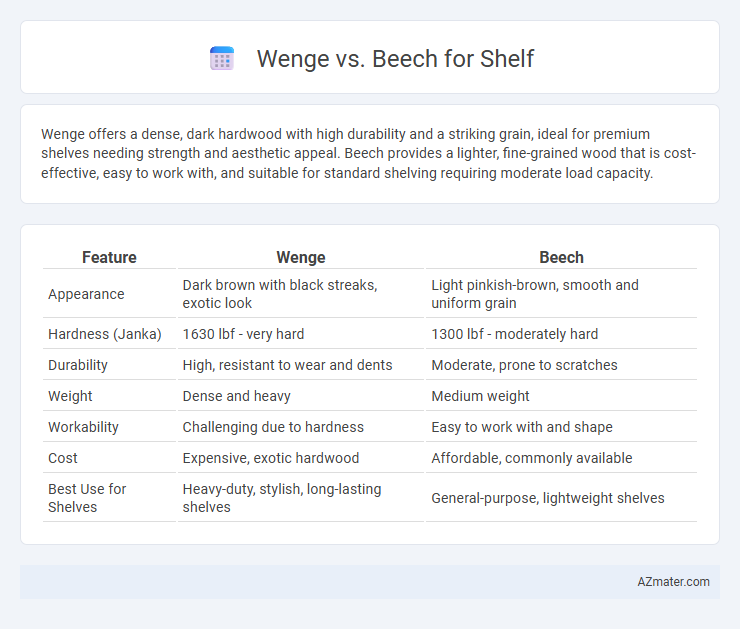Wenge offers a dense, dark hardwood with high durability and a striking grain, ideal for premium shelves needing strength and aesthetic appeal. Beech provides a lighter, fine-grained wood that is cost-effective, easy to work with, and suitable for standard shelving requiring moderate load capacity.
Table of Comparison
| Feature | Wenge | Beech |
|---|---|---|
| Appearance | Dark brown with black streaks, exotic look | Light pinkish-brown, smooth and uniform grain |
| Hardness (Janka) | 1630 lbf - very hard | 1300 lbf - moderately hard |
| Durability | High, resistant to wear and dents | Moderate, prone to scratches |
| Weight | Dense and heavy | Medium weight |
| Workability | Challenging due to hardness | Easy to work with and shape |
| Cost | Expensive, exotic hardwood | Affordable, commonly available |
| Best Use for Shelves | Heavy-duty, stylish, long-lasting shelves | General-purpose, lightweight shelves |
Introduction: Wenge vs Beech for Shelving
Wenge, known for its deep, dark brown color and dense grain, offers exceptional durability and a sleek, modern aesthetic for shelving. Beech, characterized by its light, creamy hue and fine, even texture, provides a versatile and cost-effective option with good strength and smooth finish. Choosing between Wenge and Beech for shelves depends on desired visual impact, durability needs, and budget considerations.
Overview of Wenge Wood Characteristics
Wenge wood is known for its deep, dark brown color with black streaks, offering a rich and luxurious appearance ideal for shelves requiring striking aesthetics. Its dense, hard texture provides exceptional durability and resistance to wear, making it suitable for heavy-duty storage solutions. Compared to beech, wenge's natural oils give it increased resistance to moisture and warping, enhancing shelf longevity in humid environments.
Key Properties of Beech Wood
Beech wood features a fine, even grain and pale cream color that darkens slightly over time, making it highly desirable for shelves requiring a clean, uniform appearance. Its high hardness (around 1,300 on the Janka scale) and excellent shock resistance provide durability and long-lasting strength for heavy loads. Beech also resists wear and dents better than many hardwoods, ensuring shelf surfaces remain smooth and visually appealing in high-traffic or frequently used storage areas.
Strength and Durability Comparison
Wenge wood offers exceptional strength and durability, known for its high density and natural resistance to wear, making it ideal for heavy-use shelving. Beech wood, while strong and hard, is slightly less dense than Wenge but provides a fine, uniform grain that resists warping and cracking under normal shelving conditions. Choosing Wenge ensures long-lasting performance in demanding environments, whereas Beech balances durability with a lighter appearance and ease of finishing.
Color and Aesthetic Differences
Wenge wood features a rich, dark brown color with deep, chocolate undertones and subtle black streaks, offering a modern and sophisticated aesthetic ideal for sleek and contemporary shelves. In contrast, Beech wood showcases a lighter, warm beige to pale reddish-brown hue with a fine, uniform grain pattern that brings a soft, natural, and classic appearance to shelving units. The bold, dramatic look of Wenge contrasts sharply with the airy, inviting feel of Beech, influencing the overall ambiance and style of interior spaces.
Workability and Ease of Installation
Wenge wood offers excellent workability with its dense grain, allowing precise cuts and smooth finishes but requires sharp tools to avoid splintering. Beech is highly favored for its ease of installation due to its consistent grain and moderate hardness, making it less prone to cracking or warping. Both woods provide durable shelf options, but Beech's straightforward workability often results in faster assembly and fewer installation challenges.
Maintenance and Longevity
Wenge wood offers exceptional durability and resistance to wear, making it a low-maintenance choice for shelves that require long-lasting strength. Beech, while also sturdy, demands more frequent upkeep such as polishing and protection from moisture to prevent warping or discoloration. For longevity, Wenge's dense grain structure ensures better resistance to scratches and environmental changes compared to Beech's softer texture.
Cost and Availability
Wenge wood, known for its dark, rich color and durability, is generally more expensive than Beech due to its rarity and import costs. Beech is widely available and more affordable, making it a popular choice for budget-conscious shelf construction. Availability of Wenge is limited in many markets, while Beech is easily sourced from sustainable forests globally.
Environmental Impact and Sustainability
Wenge wood, sourced primarily from tropical African rainforests, often faces criticism for contributing to deforestation and biodiversity loss due to high demand and slow growth rates. Beech, predominantly found in European forests managed under sustainable forestry practices, offers a lower environmental impact with faster regeneration and certification options such as FSC. Choosing beech for shelves supports sustainable sourcing and reduces ecological harm compared to wenge's more vulnerable harvesting origins.
Best Applications: Which Wood Suits Your Shelf?
Wenge's dense, dark grain makes it ideal for shelves that require high durability and a modern, bold aesthetic, suitable for heavy items and contemporary interiors. Beech offers a lighter, more uniform texture with excellent shock resistance, making it perfect for shelves in casual or rustic settings that hold lighter objects like books or decorative items. Choosing between wenge and beech depends on the shelf's load requirements and the desired visual impact in your space.

Infographic: Wenge vs Beech for Shelf
 azmater.com
azmater.com